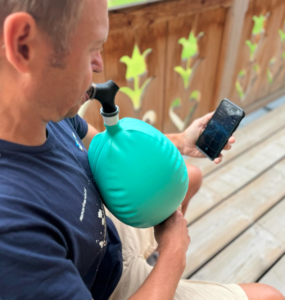By: Dr. Andrew Sellars

In the pursuit of athletic excellence, finding better methods to enhance recovery between high-intensity efforts is incredibly important. Isocapnic training with the BWB is proving to be a game-changer for athletes seeking a fuller, faster recovery. This innovative approach, rooted in controlled breathing exercises, is garnering attention for its potential to reduce fatigue and improve performance across a variety of sports.
A recent study published in the BMC Sports Science, Medicine and Rehabilitation Journal examined the effectiveness of Voluntary Isocapnic Hypernoea (VIH) on recovery between high-intensity intervals. In this particular study, researchers focused on elite short track speed skaters, but we believe the results are applicable across many interval sports, such as ice hockey, soccer, CrossFit, and basketball. Note: VIH is the scientific term used in this study for BWB training.
The fascinating results of this study confirm what we have observed in various uses of the BWB over the years, showing a reduction in perceived fatigue levels in highly trained individuals. At first glance, it may seem counterintuitive that high-intensity Isocapnic breathing could actually improve recovery, and the physiological explanation for these results is still not clearly understood.
We believe there are likely both cardiovascular and metabolic effects of this type of respiratory muscle training that allow for the observed recovery improvements. Reduction of post-exercise lactate values has been shown in previous studies and has been attributed to the respiratory muscles themselves utilizing lactate as a fuel source during the rest period. These lower lactate values have been associated with improved performance in subsequent intervals, forming the basis for some of the protocols we have developed specifically for ice hockey players to use both in training and in game situations.
In this particular study design, the BWB intervention did not alter lactate values after 3 minutes of rest. This is not unexpected, as we believe the breathing intervention was likely timed too long after the short high-intensity interval session to make a noticeable difference. We think that if the rest intervals were shortened in future studies, the lactate dynamics might be more consistent with the previously observed results.
The highlight of this study that should be noted for both coaches and athletes involved in high-intensity sports is the statistically significant reduction in fatigue reported by those who did just 3 minutes of BWB at a rate of 20 breaths per minute, with encouragement to use full deep breaths, engaging their diaphragm, and limiting accessory muscle use.
We look forward to further studies and have already created a number of programs available in the app to help teach and direct athletes wishing to incorporate BWB training into their interval training sessions.
Kowalski, T., Wilk, A., Rębiś, K. et al. Influence of voluntary isocapnic hyperpnoea on recovery after high-intensity exercise in elite short-track speedskaters – randomized controlled trial. BMC Sports Sci Med Rehabil 16, 137 (2024). https://doi.org/10.1186/s13102-024-00927-0



